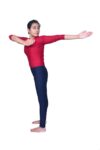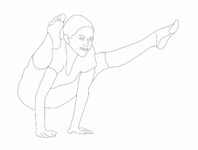“While lying on the ground, stretch your legs as straight as sticks. Catch hold of your feet with your hands behind the back. Adjust your body so that it takes the shape of a bow. Roll to and fro. This is Dhanurasana, according to Yogis. (Verse 1:19)” – Gherand Samhita
Dhanurasana is a Sanskrit word comprised of ‘Dhanu’, which means bow, and asana, which indicates yoga pose, is good for health and well-being.

How to do Bow Pose in Yoga step by step
- Begin by lying flat on your stomach (prone position) on a yoga mat or a comfortable surface. Keep your legs straight and your arms resting alongside your body, palms facing up.
- Now, bend your knees and bring your heels as close to your buttocks as possible. Your feet should be hip-width apart.
- Reach back with your hands and try to grasp your ankles. It’s common for beginners to have difficulty reaching their ankles, so you can use a yoga strap or a towel looped around them to help you hold on to them.
- Once you’ve got a grip on your ankles, make sure your big toes touch each other. This helps maintain balance during the pose
- Try to straighten your legs, which leads to arching your back and lifting your thighs, chest and head off the ground.
- The arms should remain straight and passive.
- Could you hold the head back and raise the chin?
- Be there as long as you can.
- Come to the original position slowly.
Precautions
- While reaching your hands back, you should clasp your ankles, not your feet.
- The body should rest on the ribs instead of the abdomen.
- The arms should be straight throughout the entire practice.
- It shouldn’t be practised before bed as it may disturb sleep patterns.
- Knees and shoulder width should be equal while practising.
Contraindications
There are some limitations associated with the practice of bow pose. It should be taken care of while practising.
- Heart problems
- High blood pressure
- Hernia, peptic ulcer, appendicitis and colitis
- Server backache
- Sciatica
Breathing
- First, exhale and then inhale deeply in the starting position.
- Hold your breath as you raise the body, stay in the final pose and return to the ground.
- Please let me know when you have returned to the starting position.
Variations and Modifications
Variation 1
- This method is the same as the primary technique already described but with one notable difference: the breathing is deep and slow in the final pose.
- Instead of holding your breath, breathe slowly and deeply.
- Try to accentuate the rhythmical expansion and contraction of the abdomen with the breathing.
- You can stay in the final pose without strain for as long as possible.

Variation 2 – for beginners
- The following is a simplified version of dhanurasana. It is called saral dhanurasana (easy bow pose).
- Could you take the starting position described for the basic technique?
- Place both the knees and feet together.
- Breathe out deeply. Breathe in deeply.
- Tense the leg muscles and bend the feet backwards towards the head as far as possible.
- Keep the knees and the thighs on the ground throughout the practice; don’t raise them.
- Try to raise the head and chest as high as possible off the ground, using only the leverage of the legs.
- Let the back muscles remain passive.
- This is the final position.
Variation 3 – rocking
- While in the final pose, one can rock to and fro on the abdomen. This increases the massage of the inner organs. To initiate this rocking movement, it will be necessary to both:
- Alternately tense and relax the leg muscles slightly.
- Breathe in and out.
- Both of these actions change the position of the centre of gravity and induce a forward and backward movement.
- At first, the movement will be slight, but it will increase as the body gains momentum.
- When in full motion, the chin will nearly touch the floor at one extreme, and the thighs will touch the base at the other extreme.
- Do as many rocking movements as you can without excessive strain.
Benefits
- Dhanurasana duplicates the benefits of Bhujangasana and Shalabhasana.
- Dhanurasana is very useful for overcoming lethargy and sluggishness in mind and body.
- It directly affects the solar plexus at the navel, a large sympathetic nervous centre necessary for the healthy functioning of the body’s organs.
- It decongests the entire abdominal region and its organs. The liver, the multi-duty organ of digestion, is massaged, leading to improved digestion.
- The pancreas is toned up to secret the correct amount of glucagon and insulin at the right time.
- The entire alimentary canal is reconditioned, as well as accessory glands. Blood is encouraged to flush through the whole system, which acts as a cleaning process.
- The kidneys are more efficient, leading to better bodily fluid balance.
- It helps to alleviate constipation, dyspepsia, sluggishness of the liver, diabetes and excess fat.
- The spinal column is realigned and rejuvenated.
- The deep muscles of the back are exercised, which recirculates stagnant blood.
- Dhanurasana realigns the back and thereby improves the breathing processes. This, in turn, leads to the free flow of air through the nasal passages.
Preparatory poses
- Locust pose
- Cobra Pose
Follow-up poses
- Camel Pose
- Wheel pose






